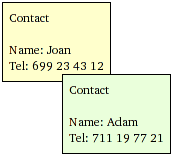Kexi/Handbook/Introduction to Databases/What Is a Database?
What Is a Database?
You can define a database as a collection of data on one topic. It is organised in a way allowing to easily browse the information, make changes or add new items.
Look at this diagram for one of the above examples: a simple phone book.

The above picture shows a set of two contacts each of which is presented on a separate card. It appears that such a card can constitute a single row in a table:
| Name | Tel No. |
|---|---|
| Joan | 699 23 43 12 |
| Adam | 711 19 77 21 |
Terms and definitions: A single data which constitutes a part of a greater collection can be called a row or more professionally a record. The collection is normally called a table. Moreover, the most natural name for the table is one describing the data it offers/stores which is Contacts. Furthermore, each row in the table consists of columns often also called fields. In the table Contacts there are two columns (fields): Name and Tel No..
For simple uses a single table can make up a database. Many people consider these two equivalent. As you will see, for real databases we usually need more than one table.
To sum up, you have already got a simple database with one table Contacts.

